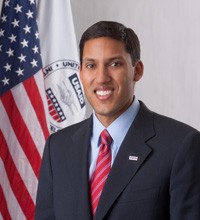Nearly all the many development challenges USAID faces today converge in one form or another in Haiti, USAID's highest development priority in the Western hemisphere. I'm encouraged by the progress the country has made over the past year. In coordination with other donors and in support of the government of Haiti, USAID has saved countless lives, begun to build the country back better, and strengthened the government's capacity to provide for its citizens. The number of Haitians living in camps has fallen by half a million since last spring. The U.S. government alone has removed nearly 1.5 million cubic meters of rubble. More Haitians have access to clean water and health services today than before last year's devastating earthquake.
As we move into the second year of post-earthquake recovery and reconstruction, we are working hard to implement a new approach to development.
We are partnering successfully with Haitian government institutions to respond to the cholera epidemic, address security, and boost the economy. Thanks to the leadership of the Haitian Ministry of Health, with the support of the international community, the cholera epidemic has stabilized, with the number of cases growing more slowly and the fatality rate down.
We are ramping up our partnerships with the private sector to generate jobs and benefit from innovative approaches to tackling development challenges. For example, spurred on by an incentive fund created by USAID and the Gates Foundation, the telecommunications company Digicel introduced a mobile banking service that will provide any Haitian with a cell phone with access to financial services. (See related story on mobile banking.)
And we are including the Haitian people in the reconstruction effort. As contracts are awarded in the coming months, we will be reaching out to Haitian organizations to maximize their ability to compete. To the extent possible, we want to partner with local entities, rather than outside contractors, in order to creating lasting local capacity.
To be sure, the challenges before us are still formidable. With over 800,000 Haitians still living in camps, moving people into safe, resilient housing is one of our top priorities. Another is clearing away the remaining rubble. To make more progress on this front, we need help from other donors and the Haitian government in addressing land tenure issues, and prioritizing funding for rubble removal and resettlement of the displaced.
Beyond these immediate needs, Haiti's long-term development plan is now in place, with the United States' efforts focused on four areas: infrastructure, health, agriculture, and governance. In a major reconstruction development last month, we reached agreement with the Inter-American Development Bank and one of the world's largest garment makers, Sae-A of South Korea, to develop an industrial park with the potential to double the size of Haiti's textile sector. (See related story on Haitian industry.)
Despite the daunting challenges in Haiti, I am hopeful about the country's prospects. We have been encouraged by the ability of Haitian government agencies to rebound from the devastating earthquake and will be eager to work with the new government when it comes on board. But fundamentally, it is the tenacity and resilience of the Haitian people that inspire and drive us. Their unrelenting determination not just to survive, but to thrive, reminds us all of what is in reach when we join forces for the common good.










Comment
Make a general inquiry or suggest an improvement.